Ellington, Douglas D. (1886-1960)
Birthplace:
Johnston County, North Carolina, USA
Residences:
- Charleston, South Carolina
- Washington, D.C.
- Asheville, North Carolina
- Pittsburgh, Pennsylvania
Trades:
- Architect
NC Work Locations:
Building Types:
Styles & Forms:
Art Deco; Georgian Revival
Douglas D. Ellington (1886-1960), architect, a North Carolina native trained at the École des Beaux Arts, is best known for designing Asheville’s outstanding Art Deco buildings of the 1920s. One of the most important architects practicing in North Carolina during the mid-20th century, Ellington developed a unique synthesis of Beaux Arts classicism, modern functionalism, and Art Deco styling that capped Asheville’s pre-Depression boom.
Douglas Ellington was born to Jesse and Sallie Ellington and grew up on a farm in Johnston County, North Carolina, with his two younger brothers, Kenneth and Eric. He was an imaginative child who preferred drawing and painting to athletics. After completing his general education at Randolph-Macon College in Virginia, he studied architecture at Drexel Institute and the University of Pennsylvania before winning the 1911 Paris Prize from the Society of Beaux-Arts Architects, an award that provided for study at the École des Beaux-Arts in Paris. In 1913 Ellington won the Prix de Rougevin, the top honor for decorative competitions at the École, and was the first American ever to do so. He traveled widely while in Europe.
During World War I, he served in the United States Navy, utilizing his artistic skills in the newly formed camouflage unit. The art of military camouflage was developed during World War I to conceal strategic objects and personnel from the newly prevalent enemy aircraft, and many architects, artists, and others participated in creating effective camouflage designs. He later taught in the Beaux Arts influenced architecture programs at Drexel, Columbia University, and the Carnegie Institute of Technology.
Ellington opened an office in Pittsburgh in the first half of the 1920s with his brother Kenneth as business manager, and his work during these years shows a relatively rapid evolution from the classical vocabulary of the Beaux Arts to the modern aesthetic of Art Deco. Ellington relocated his office to Asheville, North Carolina, in 1926, after he was awarded the commission for the First Baptist Church (1925-1927). His design consisted of Neoclassical building forms integrated with decorative patterns and surface ornament that reflected the fashionably modern Art Deco style.
Championed by Mayor John Cathey, Ellington’s design for the Asheville City Building (1926-1928), which was originally conceived with a tandem county courthouse, further combined Beaux-Arts planning with modern stylized decorative motifs that signal his development of an Art Deco idiom specifically tailored to the environment of Asheville. The City Building directly refers to the colors and contours of the surrounding mountain landscape, incorporates Native American motifs, and responds to the rapid modernization of the city.
Departing from the bold new style of Ellington’s City Building the county commissioners rejected his design for the courthouse and chose to erect the large Buncombe County Courthouse in a more conservative classical style from a design by architects Milburn and Heister. But the monumental Asheville High School (1927-1929) took an innovative form, with a hexagonal entry tower from which radiate three equal-sized wings—two for classrooms and the third for an auditorium. The school’s ordered plan and massing play against its rough granite exterior and organic tile and stone accents.
Ellington’s most refined example of the Art Deco style, the S&W Cafeteria (1929), is a colorful, carefully detailed composition of glazed terra cotta panels, slate, glass, and wrought iron topped by a crenellated parapet of green and blue tiles. The brightly colored façade and richly decorated interior dining rooms provided a thoroughly modern venue for the new restaurant type in Asheville. Ellington’s distinctive vocabulary of forms and decorative elements also appears in his less visible commissions such as the understated Merrimon Avenue Fire Station (1926-1927), consisting of highly articulated rectangular masses of rose colored brick, arched truck bays, and a tall training tower at the rear. Robert J. Lewis, funeral home director and chairman of the First Baptist Church building committee, commissioned the Lewis Memorial Park Cemetery Office (1927), a monument-like structure capped by an octagonal roof and flanked by arched gateways with stylized lettering and floral images. Ellington’s 4-story, 65-room Biltmore Hospital (1929-1930) combined brick and stone with little enrichment on the exterior of this modern medical facility. For his own home, the Douglas Ellington House (1926-1930), the architect built onto a log structure standing on the site and incorporated materials salvaged from his other projects. Inspired by European vernacular cottages, he refused to draw plans for the house and employed a trained stonemason along with local unskilled laborers to achieve the romantic informality of the rambling exterior in contrast with the ordered interior spaces. The house was recognized by House Beautiful and Architectural Digest magazines in the 1930s.
The real estate boom of the late 1920s that nurtured Ellington’s creative output in Asheville ended suddenly with the economic depression of 1930, and Ellington moved to Washington, D.C., to serve as principal architect, along with Reginald Wadsworth, for the federally sponsored new town of Greenbelt, Maryland. Ellington and Wadsworth are credited with designing the town’s Community Center and hundreds of housing units. In 1937, Ellington relocated to Charleston, South Carolina, to oversee the reconstruction of the historic Dock Street Theater. He re-established his office in Charleston and designed numerous churches, residences, and government housing projects there, as well as facilities associated with the Charleston Naval Base during the 1940s and 1950s. Although he never lived fulltime in Asheville again, Ellington returned regularly during the summers and, in the late 1940s and early 1950s, worked on a number of residential projects in the Asheville area. He took time to get to know his clients’ needs and tastes over extended visits before beginning a project, and although his later residential work generally lacks the decorative flair of his earlier buildings, the houses bear Ellington’s unique stamp. The Reynolds-Oertling House (1946) on Reynolds Mountain north of town is a rambling 1-story log and stone dwelling with a front stone terrace and 270-degree view of the mountains. The house was built for Senator Robert R. Reynolds and his daughter, Francis Reynolds Oertling. For Kells Castle (1949-1950), the residence of Sanford and Rose Brown, Ellington took inspiration from the Book of Kells in designing the house, using exposed cinder block with red brick banding and accents and a red tile roof. The Stribling House (1954) on Elk Mountain Scenic Highway was conceived with a bold, geometric plan of overlapping circles centered on a large circular living room with a 270-degree view.
Ellington died in 1960 at his home at Chunn’s Cove, and was buried nearby beneath a simple, carved stone of his own design. In reporting his death, the Asheville Citizen-Times of August 28, 1960, recalled that he had come to the city in the 1920s, “and some of this city’s most beautiful buildings were designed by him.” Although some of Ellington’s drawings have been lost, many others survived in the ownership of his niece, Sallie Middleton, and now approximately 320 of his drawings plus photographs and other materials are in the Douglas Ellington Collection, Asheville Art Museum.
- Catherine W. Bishir, North Carolina Architecture (1990).
- Catherine W. Bishir, Michael T. Southern, and Jennifer F. Martin, A Guide to the Historic Architecture of Western North Carolina (1999).
- David R. Black, Historic Architectural Resources of Downtown Asheville, North Carolina (1979).
- Charlotte Vestal Brown Papers, Special Collections Research Center, North Carolina State University Libraries, Raleigh, North Carolina.
- Douglas Ellington Collection, Asheville Art Museum, Asheville, North Carolina.
- Clay Griffith, “An Inventory of Douglas Ellington’s Architectural Work in Western North Carolina,” in Robert S. Brunk, ed., May We All Remember Well: A Journal of the History and Cultures of Western North Carolina, Vol. 2 (2001).
- Clayton W. Griffith, “Douglas D. Ellington: Art Deco in Asheville, 1925-1931,” M.A. thesis, University of Virginia (1993).
- Douglas Swaim, ed., Cabins and Castles: The History and Architecture of Buncombe County, North Carolina (1981).
- Daniel J. Vivian, “Public Architecture, Civic Aspirations and the Price of ‘Progress’: A History of the Buncombe County Courthouse,” in Robert S. Brunk, ed., May We All Remember Well: A Journal of the History and Cultures of Western North Carolina, Vol. 2 (2001).
Asheville City Building
Contributors:Douglas D. Ellington, architectDates:1926-1928
Location:Asheville, Buncombe CountyStreet Address:70 Court Plaza, Asheville, NC
Status:Standing
Type:Public
Images Published In:Architectural Record, 64.2 (Aug. 1928).
Catherine W. Bishir, North Carolina Architecture (1990).
Catherine W. Bishir, Michael T. Southern, and Jennifer F. Martin, A Guide to the Historic Architecture of Western North Carolina (1999).
Clay Griffith, “An Inventory of Douglas Ellington’s Architectural Work in Western North Carolina,” in Robert S. Brunk, ed., May We All Remember Well: A Journal of the History and Cultures of Western North Carolina, Vol. 2 (2001).Note:Ellington’s drawings for the Asheville City Building are in the Edgar M. Lyda Collection, D. H. Ramsey Library, Special Collections, University of North Carolina at Asheville, and may be seen on the web. Ellington fashioned models of both the City Building and similar Buncombe County Courthouse. The models survive, although the county commissioners chose Milburn and Heister for the courthouse.
Asheville High School
Contributors:Douglas D. Ellington, architectDates:1927-1929
Location:Asheville, Buncombe CountyStreet Address:419 McDowell St., Asheville, NC
Status:Standing
Type:Educational
Images Published In:Architectural Record, 66 (Sept. 1929).
Clay Griffith, “An Inventory of Douglas Ellington’s Architectural Work in Western North Carolina,” in Robert S. Brunk, ed., May We All Remember Well: A Journal of the History and Cultures of Western North Carolina, Vol. 2 (2001).Note:According to Justin Bristol’s research on the high school, the large project attracted applications from several leading architects: Warner & McCornack of Cleveland, Ronald Greene for John Russell Pope, Douglas D. Ellington, A. Ten Eyck Brown, Northup and O’Brien, Edward & Sayward of Atlanta, and Christopher Gadsden Sayre. The first ballot went for Ellington-5, Brown-3, and Sayre-2. The second ballot selected Ellington by a clear majority. The contract was formalized on March 3, 1927. See Justin Bristol, “Asheville High School: A Grand Project Built During Asheville’s Population Explosion,” Senior Thesis, History Department, University of North Carolina at Asheville (2004).
Biltmore Hospital
Contributors:Douglas D. Ellington, architectDates:1929-1930; 1953 [addition]
Location:Asheville, Buncombe CountyStreet Address:14 All Souls Crescent, Asheville, NC
Status:Standing
Type:Health Care
Images Published In:Asheville Citizen-Times, July 16, 1930.
Clay Griffith, “An Inventory of Douglas Ellington’s Architectural Work in Western North Carolina,” in Robert S. Brunk, ed., May We All Remember Well: A Journal of the History and Cultures of Western North Carolina, Vol. 2 (2001).
C. C. Peek House
Contributors:Douglas D. Ellington, architectDates:1948 [remodeled]
Location:Asheville, Buncombe CountyStreet Address:128 Windsor Rd., Asheville, NC
Status:Standing
Type:Residential
Images Published In:Douglas Ellington Collection, Asheville Art Museum, Asheville, North Carolina.
Clay Griffith, “An Inventory of Douglas Ellington’s Architectural Work in Western North Carolina,” in Robert S. Brunk, ed., May We All Remember Well: A Journal of the History and Cultures of Western North Carolina, Vol. 2 (2001).
Cazel House
Contributors:Douglas D. Ellington, architectDates:1950s
Location:Asheville, Buncombe CountyStreet Address:131 Shelburne Rd., Asheville, NC
Status:Standing
Type:Residential
Images Published In:Douglas Ellington Collection, Asheville Art Museum, Asheville, North Carolina.
Clay Griffith, “An Inventory of Douglas Ellington’s Architectural Work in Western North Carolina,” in Robert S. Brunk, ed., May We All Remember Well: A Journal of the History and Cultures of Western North Carolina, Vol. 2 (2001).
Chimney Rock Park Gateway
Contributors:Douglas D. Ellington, architectDates:1934
Location:Chimney Rock, Rutherford CountyStreet Address:US 74, Chimney Rock, NC
Status:Standing
Type:Public
Images Published In:Catherine W. Bishir, Michael T. Southern, and Jennifer F. Martin, A Guide to the Historic Architecture of Western North Carolina (1999).
Douglas Ellington Collection, Asheville Art Museum, Asheville, North Carolina.
Clay Griffith, “An Inventory of Douglas Ellington’s Architectural Work in Western North Carolina,” in Robert S. Brunk, ed., May We All Remember Well: A Journal of the History and Cultures of Western North Carolina, Vol. 2 (2001).
North Carolina Collection, Pack Memorial Library, Asheville, North Carolina.
Dalton House
Contributors:Douglas D. Ellington, architectDates:1954 [addition]
Location:Asheville, Buncombe CountyStreet Address:103 Wembley Rd., Asheville, NC
Status:Standing
Type:Residential
Images Published In:Douglas Ellington Collection, Asheville Art Museum, Asheville, North Carolina.
Clay Griffith, “An Inventory of Douglas Ellington’s Architectural Work in Western North Carolina,” in Robert S. Brunk, ed., May We All Remember Well: A Journal of the History and Cultures of Western North Carolina, Vol. 2 (2001).
Douglas Ellington House
Contributors:Douglas D. Ellington, architectDates:1926-1930
Location:Asheville, Buncombe CountyStreet Address:583 Chunns Cove Rd., Asheville, NC
Status:Standing
Type:Residential
Images Published In:Clay Griffith, “An Inventory of Douglas Ellington’s Architectural Work in Western North Carolina,” in Robert S. Brunk, ed., May We All Remember Well: A Journal of the History and Cultures of Western North Carolina, Vol. 2 (2001).
American Architect, 143 (Sept. 1933).
First Baptist Church
Contributors:Douglas D. Ellington, architectDates:1925-1927
Location:Asheville, Buncombe CountyStreet Address:5 Oak St., Asheville, NC
Status:Standing
Type:Religious
Images Published In:Architectural Record 68 (Aug. 1930).
Catherine W. Bishir, North Carolina Architecture (1990).
Douglas Ellington Collection, Asheville Art Museum, Asheville, North Carolina.
Clay Griffith, “An Inventory of Douglas Ellington’s Architectural Work in Western North Carolina,” in Robert S. Brunk, ed., May We All Remember Well: A Journal of the History and Cultures of Western North Carolina, Vol. 2 (2001).
Kappa Alpha House
Contributors:Douglas D. Ellington, architectDates:1940s
Location:Chapel Hill, Orange CountyStreet Address:210 W. Cameron Ave., University of North Carolina, Chapel Hill, NC
Status:Standing
Type:Educational
Images Published In:M. Ruth Little, The Town and Gown Architecture of Chapel Hill, North Carolina, 1795-1975 (2006).
Kappa Sigma House
Contributors:Douglas D. Ellington, architectDates:1940s
Location:Chapel Hill, Orange CountyStreet Address:204 W. Cameron Ave., University of North Carolina, Chapel Hill, NC
Status:Standing
Type:Educational
Images Published In:M. Ruth Little, The Town and Gown Architecture of Chapel Hill, North Carolina, 1795-1975 (2006).
Kells Castle
Contributors:Douglas D. Ellington, architectVariant Name(s):Brown House
Dates:1949-1950
Location:Asheville, Buncombe CountyStreet Address:24 Kimberly Ave., Asheville, NC
Status:Standing
Type:Residential
Images Published In:Douglas Ellington Collection, Asheville Art Museum, Asheville, North Carolina.
Clay Griffith, “An Inventory of Douglas Ellington’s Architectural Work in Western North Carolina,” in Robert S. Brunk, ed., May We All Remember Well: A Journal of the History and Cultures of Western North Carolina, Vol. 2 (2001).
Lewis Memorial Park Cemetery Office
Contributors:Douglas D. Ellington, architectDates:1927
Location:Asheville, Buncombe CountyStreet Address:415 Beaverdam Rd., Asheville, NC
Status:Standing
Type:Public
Images Published In:Clay Griffith, “An Inventory of Douglas Ellington’s Architectural Work in Western North Carolina,” in Robert S. Brunk, ed., May We All Remember Well: A Journal of the History and Cultures of Western North Carolina, Vol. 2 (2001).
Mallett House
Contributors:Douglas D. Ellington, architectDates:1950
Location:Asheville, Buncombe CountyStreet Address:4 Boxwood Ln., Asheville, NC
Status:No longer standing
Type:Residential
Images Published In:Douglas Ellington Collection, Asheville Art Museum, Asheville, North Carolina.
Clay Griffith, “An Inventory of Douglas Ellington’s Architectural Work in Western North Carolina,” in Robert S. Brunk, ed., May We All Remember Well: A Journal of the History and Cultures of Western North Carolina, Vol. 2 (2001).
Merrimon Avenue Fire Station
Contributors:Douglas D. Ellington, architectVariant Name(s):Fire Station No. 4
Dates:1926-1927
Location:Asheville, Buncombe CountyStreet Address:300 Merrimon Ave., Asheville, NC
Status:Standing
Type:Public
Images Published In:American Architect, 133 (June 20, 1928).
Architectural Forum 46 (June 6, 1927).
Clay Griffith, “An Inventory of Douglas Ellington’s Architectural Work in Western North Carolina,” in Robert S. Brunk, ed., May We All Remember Well: A Journal of the History and Cultures of Western North Carolina, Vol. 2 (2001).
Park Avenue School Auditorium
Contributors:Douglas D. Ellington, architectDates:1927
Location:Asheville, Buncombe CountyStreet Address:30 Park Ave., Asheville, NC
Status:No longer standing
Type:Educational
Images Published In:Clay Griffith, “An Inventory of Douglas Ellington’s Architectural Work in Western North Carolina,” in Robert S. Brunk, ed., May We All Remember Well: A Journal of the History and Cultures of Western North Carolina, Vol. 2 (2001).
North Carolina Collection, Pack Memorial Library, Asheville, North Carolina.
Pettigrew House
Contributors:Douglas D. Ellington, architectDates:1951
Location:Asheville, Buncombe CountyStreet Address:602 Chunns Cove Rd., Asheville, NC
Status:Standing
Type:Residential
Images Published In:Douglas Ellington Collection, Asheville Art Museum, Asheville, North Carolina.
Clay Griffith, “An Inventory of Douglas Ellington’s Architectural Work in Western North Carolina,” in Robert S. Brunk, ed., May We All Remember Well: A Journal of the History and Cultures of Western North Carolina, Vol. 2 (2001).
Quarterman House
Contributors:Douglas D. Ellington, architectDates:1953-1954
Location:Asheville, Buncombe CountyStreet Address:15 Boxwood Ln., Asheville, NC
Status:Standing
Type:Residential
Images Published In:Douglas Ellington Collection, Asheville Art Museum, Asheville, North Carolina.
Clay Griffith, “An Inventory of Douglas Ellington’s Architectural Work in Western North Carolina,” in Robert S. Brunk, ed., May We All Remember Well: A Journal of the History and Cultures of Western North Carolina, Vol. 2 (2001).
Reynolds-Oertling House
Contributors:Douglas D. Ellington, architectDates:1946
Location:Asheville, Buncombe CountyStreet Address:Reynolds Mountain Rd., Asheville, NC
Status:Standing
Type:Residential
Images Published In:Douglas Ellington Collection, Asheville Art Museum, Asheville, North Carolina.
Clay Griffith, “An Inventory of Douglas Ellington’s Architectural Work in Western North Carolina,” in Robert S. Brunk, ed., May We All Remember Well: A Journal of the History and Cultures of Western North Carolina, Vol. 2 (2001).
S&W Cafeteria
Contributors:Douglas D. Ellington, architectDates:1929
Location:Asheville, Buncombe CountyStreet Address:56 Patton Ave., Asheville, NC
Status:Standing
Type:Commercial
Images Published In:Asheville Citizen, July 15, 1929.
Catherine W. Bishir, North Carolina Architecture (1990).
Catherine W. Bishir, Michael T. Southern, and Jennifer F. Martin, A Guide to the Historic Architecture of Western North Carolina (1999).
Douglas Ellington Collection, Asheville Art Museum, Asheville, North Carolina.
Clay Griffith, “An Inventory of Douglas Ellington’s Architectural Work in Western North Carolina,” in Robert S. Brunk, ed., May We All Remember Well: A Journal of the History and Cultures of Western North Carolina, Vol. 2 (2001).
Sluder House
Contributors:Douglas D. Ellington, architectDates:1951
Location:Asheville, Buncombe CountyStreet Address:472 Chunns Cove Rd., Asheville, NC
Status:Standing
Type:Residential
Images Published In:Douglas Ellington Collection, Asheville Art Museum, Asheville, North Carolina.
Clay Griffith, “An Inventory of Douglas Ellington’s Architectural Work in Western North Carolina,” in Robert S. Brunk, ed., May We All Remember Well: A Journal of the History and Cultures of Western North Carolina, Vol. 2 (2001).
Starnes House
Contributors:Douglas D. Ellington, architectDates:1952-1953
Location:Asheville, Buncombe CountyStreet Address:2 Clarendon Rd., Asheville, NC
Status:Altered
Type:Residential
Images Published In:Douglas Ellington Collection, Asheville Art Museum, Asheville, North Carolina.
Clay Griffith, “An Inventory of Douglas Ellington’s Architectural Work in Western North Carolina,” in Robert S. Brunk, ed., May We All Remember Well: A Journal of the History and Cultures of Western North Carolina, Vol. 2 (2001).
Stribling House
Contributors:Douglas D. Ellington, architectDates:1952-1954
Location:Asheville, Buncombe CountyStreet Address:500 Elk Mountain Scenic Highway, Asheville, NC
Status:Altered
Type:Residential
Images Published In:Douglas Ellington Collection, Asheville Art Museum, Asheville, North Carolina.
Clay Griffith, “An Inventory of Douglas Ellington’s Architectural Work in Western North Carolina,” in Robert S. Brunk, ed., May We All Remember Well: A Journal of the History and Cultures of Western North Carolina, Vol. 2 (2001).






